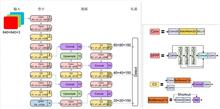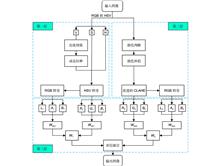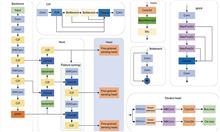 View fulltext
View fulltext
In this study, a line-focused spectral domain optical coherence tomography (LF-SD-OCT) system for imaging biological samples was built, and a data processing algorithm to improve the imaging quality was proposed to solve most of the problems of axial broadening and sensitivity attenuation caused by systematic errors. In particular, a segmented dispersion compensation method is proposed to compensate the second- and third-order dispersion phases in the imaging depth. The effectiveness and reliability of this method are verified by the imaging experiments of plane mirrors and scotch tape samples. Finally, it is proved that this method can improve the full-depth axial resolution and sensitivity without affecting the image processing speed. The final system can achieve the axial resolution of 6.76 μm and an equivalent A-scan rate of 57.2 kHz, and clearly image the tape sample within 2 mm depth and the apple sample within 0.3 mm depth. In the future, it is expected to widely realize the biological imaging applications of line-focused spectral domain optical coherence tomography.
Self-assembly of noble metal nanoparticles into superlattices can couple with plasmonic modes and light fields, holding significant promise in enhanced spectroscopy and sensing applications. However, controlling the number of layers in these self-assembled superlattice films is challenging, and small sample sizes limit their potential applications. In this study, based on a wetting-enhanced interfacial self-assembly method, we demonstrate the rapid and large-scale fabrication of monolayer densely packed nanoparticle films. Additionally, a layer-by-layer stacking method is employed to fabricate large-area, uniformly distributed gold nanoparticle superlattice films with different numbers of layers. Both experimental and computational transmission/reflection spectra indicate that the prepared superlattice samples effectively excite plasmonic modes, and higher-order plasmonic modes can also be efficiently excited with increasing superlattice layers. Moreover, adjusting the nanoparticle size enables effective modulation of the resonance peak positions of plasmonic modes. These findings provide an effective approach for the large-scale fabrication of high-quality nanoparticle superlattice films, holding promise for the design of high-performance micro/nano photonic devices.
Traffic sign detection is an important link in the field of autonomous driving, and given the problems of missed detections, false detections, many model parameters, and common and complex representative real environment conditions, such as poor robustness in foggy days, an improved YOLOv5 micro-target traffic sign recognition algorithm was proposed. Firstly, the dataset was atomized to adapt to the accurate identification in the foggy weather, and the PC3 feature extraction module was constructed by using a lighter partial convolution (PConv), and then the Extended Feature Pyramid Network (EFPN) was proposed in the neck network Finally, Focal-EIOU is introduced to replace CIOU as the loss function to solve the problem of false detection and missed detection of micro targets, and the CBAM attention mechanism is embedded to realize the lightweight model and significantly improves the feature extraction ability of the network model. Compared with the original YOLOv5 algorithm, the improved model is increased by 8.9% and 4.4% respectively on P and mAP0.5, the number of parameters is reduced by 44.4%, and the FPS value on NVIDIA 3080 device is 151.5, which can meet the real-time detection of traffic signs in the real scenes.
An image contrast and brightness enhancement algorithm for human upper gastrointestinal endoscopy is proposed to address the problem of blurring of details such as insufficient and uneven illumination in endoscopic images. The algorithm improves and weighted fusion of the adaptive gamma-corrected luminance enhancement algorithm and contrast-limited adaptive histogram equalization algorithm. The input images are processed separately and the final weighted fused enhanced image is obtained. The proposed algorithm is applied to the partial images of the upper gastrointestinal tract in the open access dataset and compared with the existing algorithms for algorithm effect testing experiments, using peak signal-to-noise ratio (PSNR), structural similarity (SSIM), and natural image quality evaluator (NIQE) as the image evaluation metrics. The experimental results show that the proposed algorithm enhances the image with higher quality than other algorithms, which significantly improves the image quality and provides a good basis for image detection.
Addressing the challenge of missed detection caused by many small targets and dense arrangement in remote sensing images, this study introduces a small target detection algorithm for remote sensing applications, leveraging a combination of feature synergy and micro-perception strategies. Initially, we propose a refined feature synergistic fusion strategy that optimizes the interaction and integration of features across different scales by intelligently adjusting the parameters of convolution kernels. This strategy facilitates progressive refinement of features from coarse to fine granularity. Building upon this foundation, a micro-perception unit is developed in this paper, incorporating perceptual attention mechanisms with moving inverse convolution to form an advanced detection head. This innovative approach substantially boosts the network's capability to detect very small objects. Furthermore, to augment the training efficiency of the model, we employ MPDIoU and NWD as regression loss functions, mitigating positional bias issues and expediting model convergence. Experimental evaluations on the DOTA1.0 dataset and DOTA1.5 dataset reveal that our algorithm achieves a substantial improvement in mean Average Precision (mAP) by 7.4% and 6.1% over the baseline method, which has obvious advantages over other algorithms. The results underscore the algorithm's efficacy in significantly reducing the incidence of missed detections of small targets within remote sensing imagery.
Aiming at the problems of existing human action recognition algorithms such as insufficient accuracy, large amount of calculation, and lack of deployment on edge devices, this paper proposes an edge-side lightweight human action recognition spatial temporal graph convolutional algorithm based on the Ascend processor. By designing an implicit skeletal connection method and constructing an implicit adjacency matrix, combined with the natural skeletal connection adjacency matrix, we create an explicit-implicit fusion spatial graph convolution. A spatial attention mechanism is added to the temporal dimension, enabling the model to focus on spatial features of joint positions across different frames. Furthermore, we design a temporal graph convolution to construct a spatiotemporal graph convolution. Additionally, the Ascend-Enisum operator is designed within the network to perform tensor fusion operations, reducing computational complexity and lightening the model. Experimental validation on the KTH dataset demonstrates that, compared to the classical single-stream ST-GCN algorithm, our model achieves a 22.28% reduction in computational cost while attaining a Top-1 accuracy of 84.17%, representing a 5% improvement. Based on this algorithm, we have designed the Ascend AI human action recognition system, which has been successfully deployed on edge devices for real-time human action recognition.
In order to improve the electrical performance of oxide thin film transistors, In-doped ZnO thin film transistors (IZO TFT) were prepared by using a sputtered IZO thin film as the active layer and an Al2O3 thin film deposited by atomic layer deposition (ALD) as the gate dielectric layer. The effects of the ratio of argon and oxygen, sputtering gas pressure, and annealing temperature on the electrical properties of IZO TFT were investigated during the IZO film preparation process. The results indicated that the IZO TFT, which was prepared at the appropriate argon-oxygen ratio and reaction pressure under relatively high annealing temperatures, shows excellent electrical characteristics. When the argon oxygen flow rate ratio was 60:20 sccm, the sputtering gas pressure was 0.5 Pa, and the air annealing temperature and time were 250 ℃ and 1 hour, respectively. The electrical properties of the IZO TFT were relatively better with a carrier saturation mobility of 31 cm2/(V·s) and a high on-off current ratio of 108. A relatively too-low or too-high argon-oxygen ratio could cause too-low or too-high oxygen vacancies in the active layer of IZO, thus reducing TFT device performance. The low annealing temperature couldn't transform the Al-OH bonds in the gate dielectric layer into Al-O bonds, and was difficult for oxygen in the air to diffuse into IZO and passivate oxygen vacancies, thus leading to poor device performance.
Light field imaging can simultaneously capture the intensity and direction information of light in a real-world scene. However, due to the limited capacity of imaging sensors, light field images captured with a single exposure struggle to fully record all the details in the real scene. To address the aforementioned issue, an unsupervised multi-exposure light field imaging method based on multi-scale spatial-angular interactions is proposed in this paper. A multi-scale spatial-angular interaction strategy is adopted to effectively extract spatial-angular features of the light field. Additionally, a channel-wise modeling strategy is employed to reduce computational complexity and adapt to the high-dimensional structure of the light field. Furthermore, a light field reconstruction module guided by reversible neural networks is constructed to avoid fusion artifacts and recover more detailed information. Lastly, an angle consistency loss is designed, considering the disparity variations between boundary sub-aperture images and the central sub-aperture image, to ensure the disparity structure of the fusion result. To evaluate the performance of the proposed method, a benchmark dataset for multi-exposure light field imaging is created, targeting real-world scenes. Experimental results demonstrate that the proposed method can reconstruct light field images with high contrast and rich details while ensuring angular consistency. Compared with the existing methods, the proposed method achieves superior results in both objective quality and subjective visual perception.
Oxygen vacancies in the a-Ga2O3 film play a crucial role in the performance of a-Ga2O3-based solar-blind photodetectors (SBPDs). The concentration of oxygen vacancies is a “double-edged sword”, increasing the responsivity of the SBPDs but deteriorating the response speed. In order to achieve a balance between these two key parameters, we adjusted the oxygen vacancy concentration in the film by delicately tuning the oxygen partial pressure during the sputtering process. The metal-semiconductor-metal (MSM) SBPDs were prepared accordingly. The results demonstrate that incorporating moderate oxygen can reduce the oxygen vacancies in the film and improve the density of the film. Under appropriate conditions, the oxygen partial pressure enables the photodetector to maintain good responsivity while having a fast response speed. At an oxygen partial pressure of 3%, the device has a high responsivity of 2.62 A/W under 254-nm DUV irradiation and a fast response speed of 2.2 s/0.96 s.














